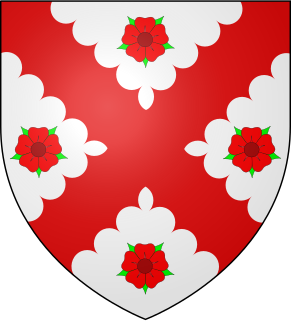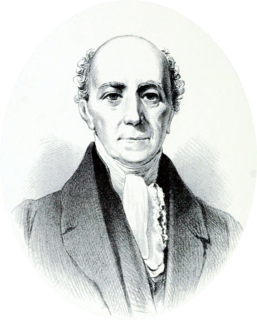Related Research Articles

Adam Ferguson, FRSE, also known as Ferguson of Raith, was a Scottish philosopher and historian of the Scottish Enlightenment.

Clan Campbell is a Highland Scottish clan. Historically one of the largest and most powerful of the Highland clans, their lands were in Argyll and the chief of the clan became the Earl and later Duke of Argyll.

A Scottish clan is a kinship group among the Scottish people. Clans give a sense of shared identity and descent to members, and in modern times have an official structure recognised by the Court of the Lord Lyon, which regulates Scottish heraldry and coats of arms. Most clans have their own tartan patterns, usually dating from the 19th century, which members may incorporate into kilts or other clothing.
A sept is a division of a family, especially of a Scottish or Irish family. The term is used in both Scotland and Ireland, where it may be translated as sliocht, meaning "progeny" or "seed", which may indicate the descendants of a person. The word may derive from the Latin saeptum, meaning "enclosure" or "fold", or via an alteration of "sect".
Cowal is a peninsula in Argyll and Bute, in the west of Scotland, that extends into the Firth of Clyde.
Arrochar is a neighborhood in northeastern Staten Island in New York City in the United States. It is located directly inland of Fort Wadsworth and South Beach, on the east side of Hylan Boulevard south of the Staten Island Expressway; the community of Grasmere borders it on the west. It is today primarily a neighborhood of one- and two-family homes and small businesses.

Arrochar is a village located near the head of Loch Long, on the Cowal peninsula in Argyll and Bute, Scottish Highlands. The village is within the Loch Lomond and The Trossachs National Park.

John Howie was a Scottish biographer. His best known work was Biographia Scoticana, first published in 1775, which is often called The Scots Worthies. It deals with Christians and particularly Presbyterians especially in their strivings with church and civil authorities.

Clan Mackay is an ancient and once-powerful Highland Scottish clan from the far North of the Scottish Highlands, but with roots in the old Kingdom of Moray. They supported Robert the Bruce during the Wars of Scottish Independence in the 14th century. In the centuries that followed they were anti-Jacobite. The territory of the Clan Mackay consisted of the parishes of Farr, Tongue, Durness and Eddrachillis, and was known as Strathnaver, in the north-west of the county of Sutherland. However, it was not until 1829 that Strathnaver was considered part of Sutherland when the chief sold his lands to the Earls of Sutherland and the Highland Clearances then had dire consequences for the clan. In the 17th century the Mackay chief's territory had extended to the east to include the parish of Reay in the west of the neighbouring county of Caithness. The chief of the clan is Lord Reay and the lands of Strathnaver later became known as the Reay Country.

Clan MacFarlane is a Highland Scottish clan. Descended from the medieval Earls of Lennox, the MacFarlanes occupied the land forming the western shore of Loch Lomond from Tarbet up-wards. From Loch Sloy, a small sheet of water near the foot of Ben Vorlich, they took their war cry of Loch Slòigh.

Clan Buchanan is a Highlands Scottish Clan whose origins are said to lie in the 1225 grant of lands on the eastern shore of Loch Lomond to clergyman Sir Absalon of Buchanan by the Earl of Lennox.

Clan Logan is a Scottish clan. Two distinct branches of Clan Logan exist: the Highland branch; and the Lowland branch. The clan does not have a chief recognised by Lord Lyon King of Arms, and therefore can be considered an armigerous clan. Today, some regard Clan MacLennan as a variant of the Highland Logan clan.

Clan Stewart of Appin is the West Highland branch of the Clan Stewart and have been a distinct clan since their establishment in the 15th century. Their Chiefs are descended from Sir James Stewart of Perston, who was himself the grandson of Alexander Stewart, the fourth High Steward of Scotland. His cousin Walter Stewart, the 6th High Steward, married Marjorie Bruce, the daughter of King Robert the Bruce, and their son Robert II was the first Stewart Monarch. The Stewarts of Appin are cousins to the Royal Stewart Monarchy.
McCloy, MacCloy or MacLoy is a Scottish surname. It is believed to have the same origins as MacLowe and MacLewis. This group of surnames are generally believed to be an offshoot of the Fullarton clan of Ayrshire – that is, a Lewis Fullarton mentioned in records from the reign of King Robert III of Scotland : "Two Sons Went out of the house of Fullarton one of the Name of Lewis and the other James. Lewis went to Arran and was called McLewis or McCloy and he Acquired Lands in Arran holding of the Croun and was made Crouner [chief officer of the Crown] of Arran." Variations including MacLewis or MacLoy are mentioned in records from the 16th century.

Clan MacAulay, also spelt Macaulay or Macauley is a Scottish clan. The clan was historically centred on the lands of Ardincaple, which are today consumed by the little village of Rhu and burgh of Helensburgh in Argyll and Bute. The MacAulays of Ardincaple were located mainly in the traditional county of Dunbartonshire, which straddles the "Highland Line" between the Scottish Highlands and Lowlands. Clan MacAulay has been considered a "Highland clan" by writers and has been linked by various historians to the original Earls of Lennox and in later times to Clan Gregor. The MacAulays of Ardincaple, like Clan Gregor and several other clans, have traditionally been considered one of the seven clans which make up Siol Alpin. This group of clans were said to have claimed descent from Cináed mac Ailpín, King of the Picts, from whom later kings of Scotland traced their descent. The chiefs of Clan MacAulay were styled Laird of Ardincaple.

The Battle of Glen Fruin was a Scottish clan battle fought on 7 February 1603 between the Clan Gregor and its allies on one side, and the Clan Colquhoun and its allies on the other. The Clan Gregor and Clan Colquhoun were at feud due to the MacGregors carrying out raids on the Colquhoun's lands. The Colquhouns gained royal support and raised an army against the MacGregors. However, during the subsequent battle of Glen Fruin, the Colquhouns were comprehensively defeated. Glen Fruin is in the Loch Lomond area, in the county of Dunbartonshire, Scotland. In the aftermath of the battle royal policy punished the MacGregors for 150 years.
McFarland, is a variation of MacFarlane that became popular in northern Ireland, but can be found worldwide. The home of the MacFarlane clan is the parish of Arrochar at the head of Loch Lomond and Loch Long at the beginning of the western Highlands in Scotland. This area was granted by feudal charter to one of the younger sons of the second earl of Lennox in 1286. The history of this exchange is found in an old Celtic genealogy of Duncan, the eighth Earl of Lennox, who was executed in 1425. According to genealogical accounts, the first Earl of Lennox was Alwyn, followed by his son, also named Alwyn, in 1199 as the second Earl. This Alwyn had many sons, the eldest being Maldouen, the third Earl, who granted his younger brother, Gilchrist, the lands of Arrochar. Gilchrist's son Malduin was father to Parlan. In 1344, Parlan's son, Malcolm MacPharlain, renewed the charter for the lands of Arrochar from Donald, the 6th Earl of Lennox. The spelling changed over many years and times. The earliest MacFarlanes in northern Ireland appeared in documents as "mcffarlan" but eventually McFarland became a dominant spelling there, and as men moved back and forth between Ireland and Scotland, the use of the "d" appeared in Scotland as well. In early America the spelling could be McFarlin, MacFarland, McFarlan, or McFarling.

Sir Hector Og Maclean (1583–1623), or Eachann Óg Maclean in Scottish Gaelic, was the 15th Clan Chief of Clan Maclean in Scotland.

Patrick MacFarlan was a Scottish minister who served as Moderator of the General Assembly of the Church of Scotland in 1834 and as Moderator of the General Assembly of the Free Church of Scotland in 1845.
Dugald MacFarlane (1869–1956) was a Scottish minister who served as Moderator of the General Assembly of the Church of Scotland in 1937.
References
- 1 2 MacFarlane, J. (1922). History of Clan MacFarlane. Glasgow. pp. 130–33. ISBN 9785872257424.
- 1 2 Pollard and Du Toit 2005.
- ↑ Smout, T. C. (2005). "Soils, Bogs and Woods". Exploring Environmental History: Selected Essays: Selected Essays. Edinburgh UP. pp. 135–52. ISBN 9780748635146.
- ↑ Withers, Charles W. J. (2001). Geography, Science and National Identity: Scotland Since 1520 . Cambridge UP. p. 143. ISBN 9780521642026.
- ↑ Cramsie, John (2015). British Travellers and the Encounter with Britain, 1450–1700. Boydell & Brewer. p. 420. ISBN 9781783270538.